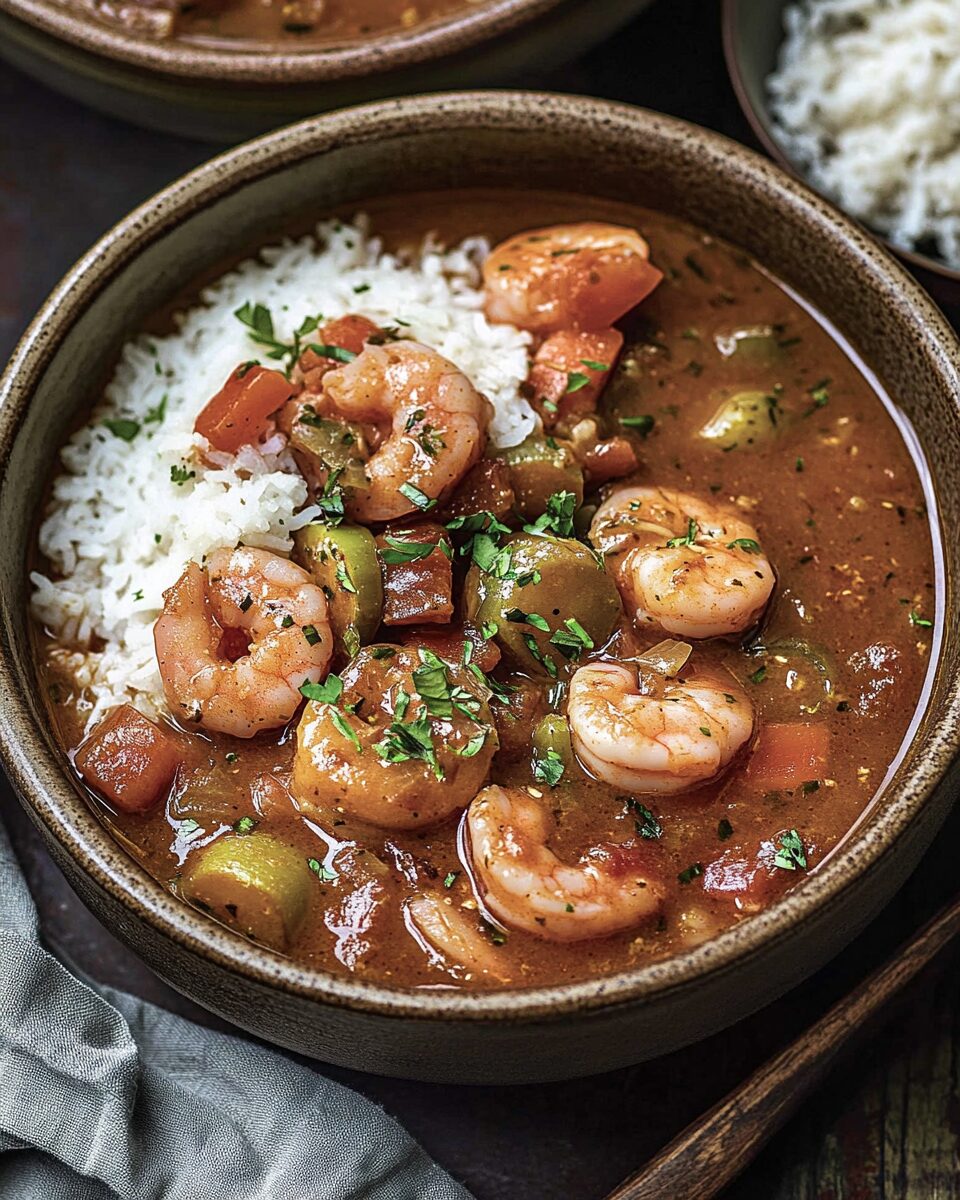This Louisiana-Style Gumbo is the ultimate comfort food rich, hearty, and packed with bold flavors. With a slow-cooked roux as its base, this dish combines smoky andouille sausage, juicy shrimp, and a medley of vegetables in a deeply flavorful broth. Served over rice, it’s a warm and satisfying meal that embodies the soul of Southern cooking. Perfect for a cozy night in or a gathering with family and friends, this gumbo takes time to prepare but is well worth the effort. The slow simmering process allows all the spices to blend beautifully, creating a rich, complex taste in every bite. Whether you’re a gumbo aficionado or trying it for the first time, this recipe is sure to become a favorite!
Full Recipe:
Ingredients:
Roux:
- ¾ cup (1½ sticks / 170 g) unsalted butter
- 1 cup (125 g) all-purpose flour
Veggie Mixture:
- 2 ribs celery, roughly chopped (about 1 cup)
- 1 large yellow onion, roughly chopped (about 1 cup)
- 1 large green bell pepper, roughly chopped, seeds removed (about 1 cup)
- 2 teaspoons garlic, minced
Gumbo:
- 10 cups (2.41 kg) beef broth
- 1 ring (14 ounces) andouille sausage, sliced into rounds
- 1 can (14.5 ounces) stewed tomatoes
- 1 can (6 ounces) tomato sauce
- 2 tablespoons hot sauce
- 1 tablespoon white sugar
- ½ teaspoon Cajun seasoning
- ½ teaspoon dried thyme leaves
- 4 teaspoons gumbo filé powder, divided
- 4 bay leaves
- 3 pounds uncooked medium shrimp, peeled, deveined
- 2 tablespoons Worcestershire sauce
- Cooked white rice, for serving
Directions:
- In a large 6-quart pot over medium-low heat, melt the butter. Once melted, add flour and whisk together until smooth. Cook, whisking constantly, until the roux turns deep brown (about 30-40 minutes). Be careful not to burn it.
- Remove from heat and continue whisking until the mixture cools slightly. Set aside.
- While the roux cools, process celery, onion, bell pepper, and garlic in a food processor until finely chopped.
- Add the vegetable mixture to the roux and stir. Place back over medium-low heat and cook until the vegetables are tender (8-12 minutes).
- Slowly whisk in the beef broth and bring to a boil (15-20 minutes).
- Reduce heat to low and add sausage, stewed tomatoes, tomato sauce, hot sauce, sugar, Cajun seasoning, and thyme. Stir and add bay leaves. Simmer uncovered for 45 minutes.
- After 45 minutes, add 2 teaspoons of gumbo filé powder, stirring to combine. Simmer for another 15 minutes.
- Remove the bay leaves, then add shrimp and Worcestershire sauce. Cook over low heat for 45-60 minutes.
- Stir in the remaining gumbo filé powder.
- Serve over cooked white rice.
Prep Time: 15 minutes | Cooking Time: 3 hours 10 minutes | Total Time: 3 hours 25 minutes
Kcal: 282 kcal | Servings: 16
The Origins of Gumbo: A Culinary Melting Pot
The word “gumbo” comes from the West African term “gombo,” which means okra. This is fitting since okra was traditionally used as a thickening agent in many early gumbo recipes. However, the dish itself is a fusion of African, French, Spanish, and Native American influences, making it a true representation of Louisiana’s diverse heritage.
A Blend of Influences
- African Influence: West African cooking traditions introduced okra and the concept of one-pot stews, which served as the foundation for early gumbo.
- French Influence: The French settlers brought the roux (a mixture of fat and flour used as a thickener), which became a key component of gumbo.
- Spanish Influence: Spanish cuisine contributed the use of tomatoes, which is a common ingredient in Creole-style gumbo.
- Native American Influence: The Choctaw people introduced filé powder, a spice made from dried sassafras leaves that helps thicken and flavor gumbo.
Over the centuries, gumbo evolved into what we recognize today: a rich, slow-simmered stew that brings together various proteins, vegetables, and bold seasonings.
Cajun vs. Creole Gumbo: What’s the Difference?
If you’ve ever looked up gumbo recipes, you’ve likely noticed two distinct styles: Cajun and Creole gumbo. While they share many similarities, a few key differences set them apart.
Cajun Gumbo
- Originates from rural Louisiana, where the Acadian (Cajun) people settled.
- Typically darker in color due to a deeply browned roux.
- Made without tomatoes.
- Usually contains chicken, sausage, or seafood, depending on the region.
- Tends to have a thicker consistency, often using filé powder or okra for thickening.
Creole Gumbo
- Developed in New Orleans and urban areas, influenced by French, Spanish, and African cooking.
- Often includes tomatoes, giving it a slightly red hue.
- Uses a lighter roux compared to Cajun gumbo.
- Features a mix of proteins, such as shrimp, crab, sausage, and sometimes even duck.
- Can be spicier and contains a wider variety of herbs and seasonings.
Both styles are delicious, and the choice between Cajun and Creole gumbo often comes down to personal preference and family traditions.
Popular Variations of Gumbo
One of the best things about gumbo is its versatility. While the classic shrimp and sausage gumbo is widely loved, there are many variations, each with its unique twist.
1. Chicken & Sausage Gumbo
This is a Cajun-style gumbo made with chicken thighs, smoked andouille sausage, and a dark roux. It’s heartier than seafood gumbo and is often served at large gatherings.
2. Seafood Gumbo
This version includes shrimp, crab, crawfish, and sometimes oysters. It’s more common in Creole-style cooking and pairs well with a lighter roux and tomato-based broth.
3. Duck & Andouille Gumbo
Duck adds a rich, gamey flavor to gumbo, making it a favorite among hunters and those who enjoy bold, meaty stews.
4. Vegetarian Gumbo (Gumbo Z’herbes)
A plant-based version of gumbo, also known as “green gumbo,” made with a mix of leafy greens like collard greens, mustard greens, and spinach.
5. Turkey Gumbo
Perfect for using up Thanksgiving leftovers, turkey gumbo combines smoky turkey meat with the classic flavors of gumbo.
Each variation highlights the flexibility of gumbo, proving that it can be customized to suit different tastes and dietary preferences.
Cooking Tips for the Perfect Gumbo
Gumbo takes time to prepare, but following these expert tips will ensure a rich, flavorful, and well-balanced dish:
1. Mastering the Roux
- The roux is the foundation of gumbo and requires patience. Stir constantly over low heat until it turns a deep brown color (this can take 30-40 minutes).
- Use butter for a rich flavor or vegetable oil for a more traditional Cajun-style roux.
2. Use the Right Sausage
- Andouille sausage is the best choice for gumbo, as it provides a smoky and spicy kick. If unavailable, smoked sausage or kielbasa can be used.
3. Let It Simmer
- Gumbo develops deeper flavors the longer it simmers. A minimum of 3 hours is ideal, but overnight storage enhances the taste even more.
4. Add Seafood at the Right Time
- Shrimp and other seafood should be added toward the end to prevent overcooking. Overcooked shrimp can become rubbery.
5. Use Filé Powder Wisely
- Filé powder should be added at the end of cooking, just before serving. If added too early, it can become slimy.
6. Serve It Right
- Always serve gumbo over white rice to soak up the rich flavors. Some people also enjoy it with cornbread on the side.
Why Gumbo is a Timeless Classic
There’s a reason why gumbo has remained one of the most beloved dishes in Southern cuisine. Beyond its bold flavors and comforting texture, gumbo carries with it a rich history, cultural significance, and a sense of community.
Bringing People Together
In Louisiana, gumbo is more than food it’s a tradition. Families gather to prepare it, stirring the roux together and sharing stories as they wait for the flavors to meld. It’s a dish that brings people closer, whether at a holiday feast, a Mardi Gras celebration, or a simple Sunday dinner.
An Ever-Evolving Dish
Gumbo’s versatility allows it to evolve while still honoring its roots. Whether you prefer Cajun or Creole gumbo, with okra or filé powder, spicy or mild, there’s a version for everyone.
Conclusion:
Gumbo is a dish that captures the heart and soul of Louisiana. With its deeply flavored broth, smoky sausage, succulent shrimp, and perfect balance of spices, it’s no wonder this dish has stood the test of time.
Whether you’re making it for the first time or you’ve been perfecting your gumbo for years, the key to great gumbo is patience, quality ingredients, and a love for the process. So, grab your pot, start your roux, and enjoy a bowl of authentic Louisiana-style gumbo it’s a meal worth savoring.






